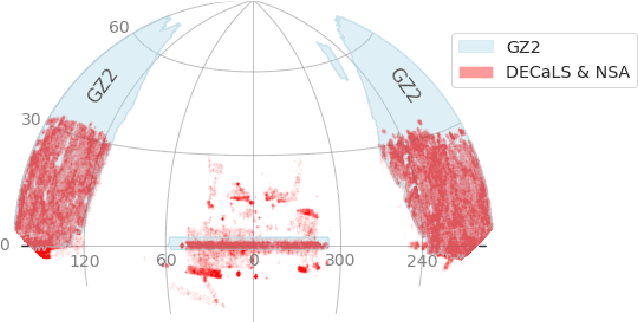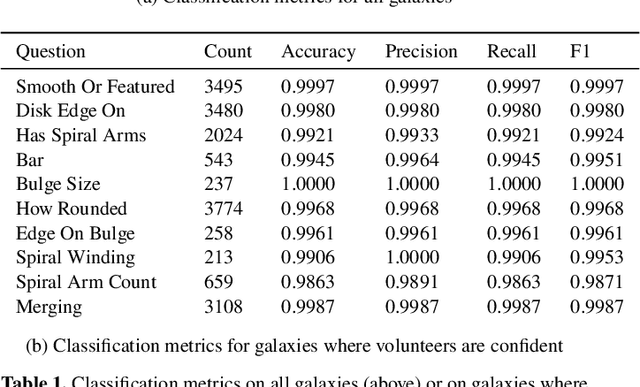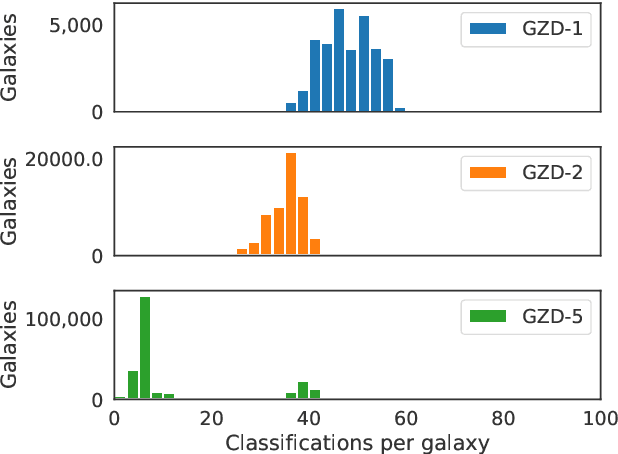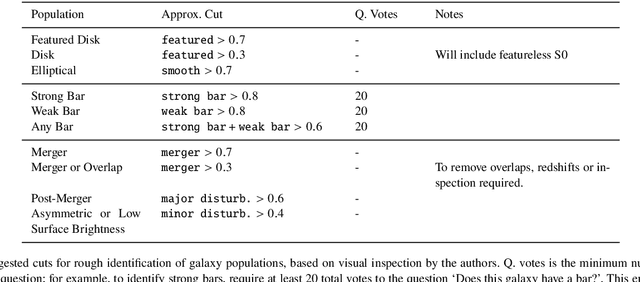Kyle W. Willett
Galaxy Zoo DECaLS: Detailed Visual Morphology Measurements from Volunteers and Deep Learning for 314,000 Galaxies
Feb 16, 2021



Abstract:We present Galaxy Zoo DECaLS: detailed visual morphological classifications for Dark Energy Camera Legacy Survey images of galaxies within the SDSS DR8 footprint. Deeper DECaLS images (r=23.6 vs. r=22.2 from SDSS) reveal spiral arms, weak bars, and tidal features not previously visible in SDSS imaging. To best exploit the greater depth of DECaLS images, volunteers select from a new set of answers designed to improve our sensitivity to mergers and bars. Galaxy Zoo volunteers provide 7.5 million individual classifications over 314,000 galaxies. 140,000 galaxies receive at least 30 classifications, sufficient to accurately measure detailed morphology like bars, and the remainder receive approximately 5. All classifications are used to train an ensemble of Bayesian convolutional neural networks (a state-of-the-art deep learning method) to predict posteriors for the detailed morphology of all 314,000 galaxies. When measured against confident volunteer classifications, the networks are approximately 99% accurate on every question. Morphology is a fundamental feature of every galaxy; our human and machine classifications are an accurate and detailed resource for understanding how galaxies evolve.
Rotation-invariant convolutional neural networks for galaxy morphology prediction
Mar 24, 2015



Abstract:Measuring the morphological parameters of galaxies is a key requirement for studying their formation and evolution. Surveys such as the Sloan Digital Sky Survey (SDSS) have resulted in the availability of very large collections of images, which have permitted population-wide analyses of galaxy morphology. Morphological analysis has traditionally been carried out mostly via visual inspection by trained experts, which is time-consuming and does not scale to large ($\gtrsim10^4$) numbers of images. Although attempts have been made to build automated classification systems, these have not been able to achieve the desired level of accuracy. The Galaxy Zoo project successfully applied a crowdsourcing strategy, inviting online users to classify images by answering a series of questions. Unfortunately, even this approach does not scale well enough to keep up with the increasing availability of galaxy images. We present a deep neural network model for galaxy morphology classification which exploits translational and rotational symmetry. It was developed in the context of the Galaxy Challenge, an international competition to build the best model for morphology classification based on annotated images from the Galaxy Zoo project. For images with high agreement among the Galaxy Zoo participants, our model is able to reproduce their consensus with near-perfect accuracy ($> 99\%$) for most questions. Confident model predictions are highly accurate, which makes the model suitable for filtering large collections of images and forwarding challenging images to experts for manual annotation. This approach greatly reduces the experts' workload without affecting accuracy. The application of these algorithms to larger sets of training data will be critical for analysing results from future surveys such as the LSST.
 Add to Chrome
Add to Chrome Add to Firefox
Add to Firefox Add to Edge
Add to Edge